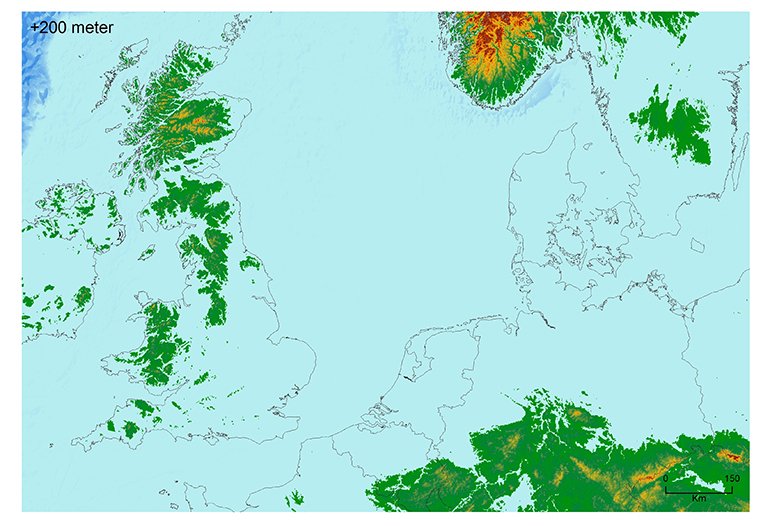Sea level reconstructed back to 540 million years ago using ice caps estimation and plate tectonics
Until recently, scientists were dependent on information about past plate tectonics when reconstructing past global mean sea level. But now, a team of Dutch, British and American Earth scientists have developed a new method for determining historic global sea level where the influence of land ice is included. As a result, it has become possible to look back 540 million years. “It is the only reconstruction in the world of its kind that goes so far back in time. For the time being, the limit of what we can reconstruct has been reached.”
Determining changes in sea level in the geological past is vital for understanding the distribution of land and oceans and natural climate change before humans evolved. Since the 1970s, scientists have estimated changes in global mean sea level by studying sediments, for example in the North Sea. But in recent years, it has become increasingly clear that this method is not sufficient, in part because vertical movements in the Earth’s crust under the continental shelf can be as significant as changes in global mean sea level. That means the effect of plate tectonics should also be taken into consideration when calculating sea level.
Big bathtub for dinosaurs
“You could compare the ocean to a big bathtub”, explains Dr. Douwe van der Meer, guest researcher at Utrecht University and main author of the study. “Plate tectonics determines the depth of the oceans. If the ‘bathtub’ becomes shallower, then the water level will rise. Ice caps on continents withhold water from the ocean, but when the ice melts, the ‘bath water level’ will rise. During the Cretaceous period (66-145 million years ago), these two effects resulted in sea level being more than 200 meters higher than they are at present. That means the water overflowed the rim of the ‘bathtub’ - today’s coastal regions - during that period. So, dinosaurs had less land and more water available than if they would have lived today.’
Plate tectonic activity
Van der Meer and his fellow Earth scientists had already come up with a new way to reconstruct sea level from plate tectonics using strontium isotopes: radioactive elements that occur naturally in stone, such as basalt. These elements are dissolved in sea water and then be deposited in limestone or rock salt. Basalt in ocean crust is less radioactive than rocks from old continents, such as granite. That means the amount of strontium isotopes in limestone or rock salt can tell us more about the proportion of ‘young’ oceanic crust at earth’s surface. And if you know how much young crust there was at a certain moment, you can derive global mean sea level at that time. “A young Earth’s crust is relatively warmer than older crust. As it cools, it shrinks, which gives it a higher density than young crust.” In other words: young oceanic crust is lighter, and therefore creates shallower oceans than older oceanic crust. The volume of water on the Earth has been approximately the same, so sea level would be higher if the average age of the oceanic crust is younger. “For the Cretaceous period, that results in a sea level rise of 150 meters.”
Ice-free
The scientists were also able to estimate the location and volume of continental ice caps based on a recent reconstruction of the Earth’s climate over time and the position of the continents in relation to the poles. The presence (or absence) of (land and shelf) ice has a major impact on sea level, in contrast to floating sea ice. The Cretaceous period was considerably warmer, on average, than temperatures today, so the poles were virtually ice-free at the time. All that melted ice resulted in an additional sea level rise of 70 meters. Van der Meer: “When you add to that the effects of plate tectonics, you get a sea level that was up to 220 meters higher in the Cretaceous than it is today. That was the highest level we were able to reconstruct over the past 540 million years.”
(Article continues below the image)

Availability of fossils
The temperature reconstruction (and the resulting ice cap reconstructions) on which this study was based cannot go farther back in time. “Because for those types of reconstructions, you need input from fossils of more-or-less advanced life forms, from which you can use to deduce other information. But those life forms only evolved around 540 million years ago, during the ‘Cambrian Explosion’ of life. The lack of sufficient fossils and other climate indicators means we can’t look farther back in time in sufficient detail.”
The study is another indication of what happens when ice caps melt. “But you have to realise that in the distant past, melting took much longer than in today’s anthropogenic climate change.”
Publication
Douwe G. van der Meer, Christopher R. Scotese, Benjamin J.W. Mills, Appy Sluijs, Aart-Peter van den Berg van Saparoea, Ruben M.B. van de Weg, ‘Long-term Phanerozoic global mean sea level: Insights from strontium isotope variations and estimates of continental glaciation’, Gondwana Research, https://doi.org/10.1016/j.gr.2022.07.014

